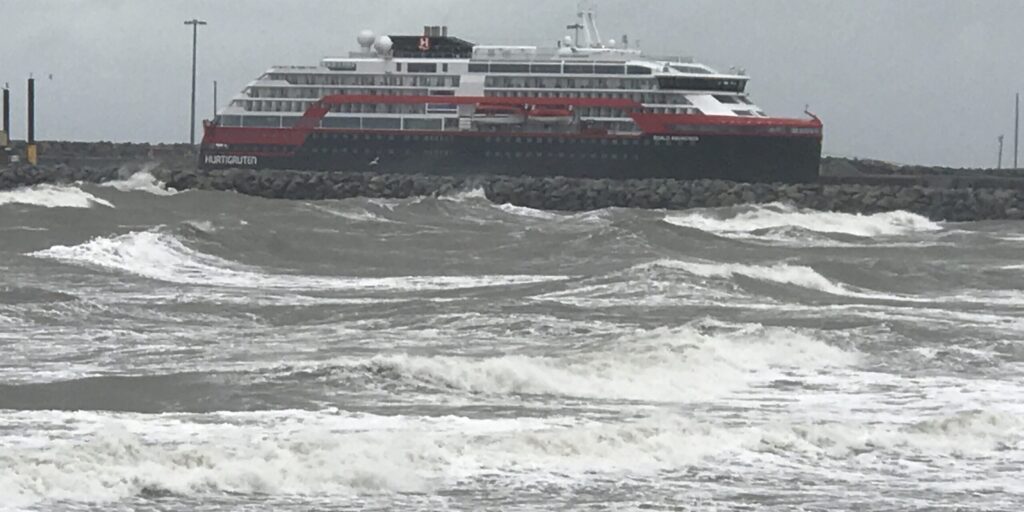The MS Roald Amundsen, a luxury expedition cruise liner, arrived in Nome early Tuesday afternoon after making its way through the Northwest Passage. Nome served as the transfer for one group to get off and another to get on.
As KNOM’s Emily Hofstaedter reports, some Nomeites are excited for the economic opportunities but are wary about what these trips mean for climate change:
About a hundred cruisers are milling around the Nome Mini Convention Center, many of them identifiable by red coats. A little patch on the arm designates them as being members of the Hurtigruten’s MS Roald Amundsen expedition ship. The room buzzes with mostly French, German, and Scandinavian languages. These visitors have just had a very different cruise experience than most of the millions of cruisers who visit Alaska every summer.
“We started in Greenland and went through the Northwest Passage, and the last place was Nome.”
That’s Werner Wallusch of Germany, who is traveling with his wife Barbara. They described seeing whales, birds, and polar bears during their trek.
The influx of visitors is short. While they are between their ship and flight, they spend time in Nome and need food, transportation, and entertainment. That provides brief economic opportunities for Nome entrepreneurs, many of whom have mixed feelings. Kristine McRae runs catering and is glad for the business but also wishes Nome would have tourists who stay longer, to get more of a feeling for the city.

Mandy Ellana and Asaaluk Irelan sit at a table on the stage, selling brightly colored stickers, paintings, headbands, and homemade earrings. Ellanna thinks the extra traffic can make people aware of the talent in Nome.
“I think that when we were younger, tourism used to be a lot more of an activity all summer long. I think it could benefit our local economy, definitely.”
But both Ellana and Irelan note that the economy isn’t the only thing changing in Nome; so is the climate. Irelan says she hasn’t necessarily been doing research but did say, “All I know is that this weather is not what I’m used to this time of year.”
There’s an electricity in the air born from the presence of so many new people and the impending storm on the horizon. But for some people, like Nome subsistence hunter and trapper Austin Ahmasuk, the very fact that these ships can be here is a concern.
“That they’re able to transit the Northwest Passage is because the world is so much dramatically warmer, and because it’s so much dramatically warmer, we here in the Bering Sea are in a climate crisis.”
Ahmasuk notes that this warming is causing the type of marine life in the ecosystem to change dramatically. Lower levels of sea ice are causing subsistence hunting to become more difficult, and scientists are seeing harmful algal blooms in the warming Chukchi Sea. In those same areas, communities are seeing large numbers of dead seabirds.
And there are other reasons for subsistence-dependent communities to be wary of cruise ships.
“When folks were testing bowhead whales, their GI tract, human zoonotic pathogens showed up, and it appeared the causal relationship of why they showed up was because of ballast water, ship ballast water, so we think that we’re seeing those biochemical changes in marine mammals.”
A zoonotic pathogen is a pathogen passed between humans and animals. KNOM has no evidence that the Roald Amundsen handled ballast water improperly.
But for researchers like Olav Orheim, it is undeniable that the Northwest Passage has changed dramatically. He particularly studies climate change and glaciers. On this trip, they saw very little ice.
“We had to go through a couple of little patches that were decently heavy, but apart from that, there was nothing.”
Orheim joins the cruise as part of the “Expedition Team,” the group of experts who provide scientific and historical lectures to entertain and inform the cruise guests. Here’s what Orheim says when asked if the cruise industry is capitalizing off of climate change:
“Well, you could use that word. Certainly, the industry is going through the Northwest Passage now, in numbers, which was unthinkable ten years and twenty years ago, and without any aid of icebreaker. So, it’s changing the picture.”
This has been Nome’s busiest cruise season to date, and it remains to be seen how much Nome will capitalize off this new kind of tourism. The Nome Chamber of Commerce hopes it can collect some solid numbers from vendors this year to be prepared for the next.
The Roald Amundsen left Nome on Wednesday and will journey back through the Northwest Passage to Greenland.
Image at top: The MS Roald Amundsen docks in a stormy Nome harbor. Photo: Emily Hofstaedter, KNOM.




